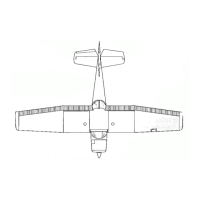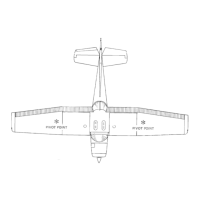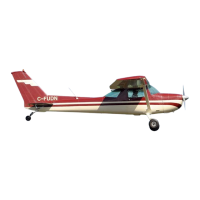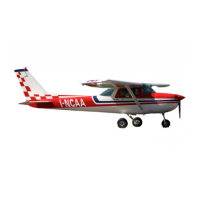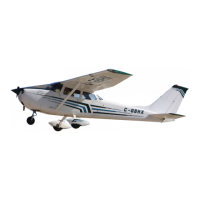Do you have a question about the Cessna 1975 150 and is the answer not in the manual?
Detailed pre-flight checks for aircraft exterior condition, including controls, fuel, and tires.
Pre-start checks including exterior, controls, fuel, and brakes.
Procedures for starting the engine, including mixture, throttle, and oil pressure.
Checks before takeoff, including controls, fuel, instruments, and engine settings.
Procedures for normal and maximum performance take-offs.
Recommended airspeeds and mixture settings for climbing.
Power settings, RPM, and mixture for normal cruising flight.
Procedures and airspeeds before initiating landing.
Actions to take for a go-around during landing approach.
Touchdown and landing roll procedures.
Post-landing procedures including flap retraction and securing.
Steps to secure the aircraft after landing, including parking brake and locks.
Details on fuel tanks, shutoff valve, strainer, and quick-drain valves.
Description of the 14-volt DC system, including master switch and ammeter.
Details on the automatic over-voltage protection system and warning light.
Information on fuses and circuit breakers protecting electrical circuits.
Details on instrument panel, compass, flap indicator, and cabin dome lights.
Description of navigation lights, landing lights, beacon, and strobe lights.
Operation and control of the electrically operated wing flaps.
Regulation of cabin airflow, temperature, and defrosting.
Procedures for setting and releasing the parking brake.
Description of standard and child seats, including adjustments and folding.
Usage and adjustment of pilot and passenger shoulder harnesses.
Operation of optional seat belts with inertia reels for enhanced safety.
Procedures for starting the engine, including priming and troubleshooting.
Guidelines for taxiing, control usage, and nose wheel steering.
Visual guide for control inputs during taxiing based on wind direction.
Procedures for engine failure after take-off and during flight.
Guidance for emergency landings without engine power.
Steps for landing in an 'off airport' area with engine power.
Procedures for ditching the aircraft in water.
Actions for engine fires during start on ground and in flight.
Procedure for handling electrical fires occurring during flight.
Guidance for maintaining control and navigating in clouds.
Steps to execute a 180° turn safely when flying in clouds.
Procedure for a safe descent through clouds using radio clearance.
Steps to recover from an uncontrolled spiral dive.
How to handle unexpected encounters with icing conditions.
Troubleshooting carburetor icing and spark plug fouling.
Detecting and addressing electrical system issues like charge rate.
Procedure for handling overcharging of the aircraft battery.
Procedure for handling undercharging of the aircraft battery.
Information on ELT operation, activation, and failure.
Steps for normal, failure, and rescue operations of the ELT.
Details on FAA certification and authorized operations for the aircraft.
Approved maneuvers, load factors, and entry speeds for utility category.
Certificated calibrated airspeed limits for the airplane.
Color-coded markings on the airspeed indicator and their meanings.
Power, speed, and instrument markings for engine operation.
Procedures for calculating weight and balance for safe loading.
Diagrams and notes on passenger and baggage loading locations.
Information on maximum baggage loads and tie-down points.
Example calculation of aircraft weight and balance.
Chart for determining if the aircraft's weight and CG are within limits.
Procedures for safe maneuvering of the aircraft on the ground.
Best practices for securing the aircraft against wind damage.
Cleaning and maintenance of plastic windshield and windows.
Cleaning and polishing procedures for painted exterior surfaces.
Maintenance for clad aluminum surfaces to maintain brightness.
Preflight inspection and cleaning of propeller blades.
Cleaning upholstery, headliner, carpet, and instrument panel.
Location and purpose of aircraft identification and trim plates.
Checklist of required documents and data to be carried in the aircraft.
Procedures for storing the aircraft in a flyable condition.
Overview of annual, 100-hour, and progressive inspection schedules.
Description of the progressive inspection schedule for optimal utilization.
Details on warranty benefits and initial inspection services.
Reference to quantities, materials, and specifications for service items.
Table for converting indicated airspeed to calibrated airspeed.
Calibrated stall speeds based on flap setting and angle of bank.
Data for take-off ground run and distance to clear obstacles.
Data on climb rates, fuel consumption, and speeds at various altitudes.
Data for landing ground roll and distance to clear obstacles.
Performance data for cruise speed, range, and fuel consumption.
Chart showing glide distance based on height above terrain.
Description of the winterization kit for improved cold weather operation.
Installation and use of external power source receptacle.
Operation of the switch for selecting radio transmitters.
Optional valve for quicker and cleaner engine oil draining.
Description and operation of the true airspeed indicator.
Detailed pre-flight checks for aircraft exterior condition, including controls, fuel, and tires.
Pre-start checks including exterior, controls, fuel, and brakes.
Procedures for starting the engine, including mixture, throttle, and oil pressure.
Checks before takeoff, including controls, fuel, instruments, and engine settings.
Procedures for normal and maximum performance take-offs.
Recommended airspeeds and mixture settings for climbing.
Power settings, RPM, and mixture for normal cruising flight.
Procedures and airspeeds before initiating landing.
Actions to take for a go-around during landing approach.
Touchdown and landing roll procedures.
Post-landing procedures including flap retraction and securing.
Steps to secure the aircraft after landing, including parking brake and locks.
Details on fuel tanks, shutoff valve, strainer, and quick-drain valves.
Description of the 14-volt DC system, including master switch and ammeter.
Details on the automatic over-voltage protection system and warning light.
Information on fuses and circuit breakers protecting electrical circuits.
Details on instrument panel, compass, flap indicator, and cabin dome lights.
Description of navigation lights, landing lights, beacon, and strobe lights.
Operation and control of the electrically operated wing flaps.
Regulation of cabin airflow, temperature, and defrosting.
Procedures for setting and releasing the parking brake.
Description of standard and child seats, including adjustments and folding.
Usage and adjustment of pilot and passenger shoulder harnesses.
Operation of optional seat belts with inertia reels for enhanced safety.
Procedures for starting the engine, including priming and troubleshooting.
Guidelines for taxiing, control usage, and nose wheel steering.
Visual guide for control inputs during taxiing based on wind direction.
Procedures for engine failure after take-off and during flight.
Guidance for emergency landings without engine power.
Steps for landing in an 'off airport' area with engine power.
Procedures for ditching the aircraft in water.
Actions for engine fires during start on ground and in flight.
Procedure for handling electrical fires occurring during flight.
Guidance for maintaining control and navigating in clouds.
Steps to execute a 180° turn safely when flying in clouds.
Procedure for a safe descent through clouds using radio clearance.
Steps to recover from an uncontrolled spiral dive.
How to handle unexpected encounters with icing conditions.
Troubleshooting carburetor icing and spark plug fouling.
Detecting and addressing electrical system issues like charge rate.
Procedure for handling overcharging of the aircraft battery.
Procedure for handling undercharging of the aircraft battery.
Information on ELT operation, activation, and failure.
Steps for normal, failure, and rescue operations of the ELT.
Details on FAA certification and authorized operations for the aircraft.
Approved maneuvers, load factors, and entry speeds for utility category.
Certificated calibrated airspeed limits for the airplane.
Color-coded markings on the airspeed indicator and their meanings.
Power, speed, and instrument markings for engine operation.
Procedures for calculating weight and balance for safe loading.
Diagrams and notes on passenger and baggage loading locations.
Information on maximum baggage loads and tie-down points.
Example calculation of aircraft weight and balance.
Chart for determining if the aircraft's weight and CG are within limits.
Procedures for safe maneuvering of the aircraft on the ground.
Best practices for securing the aircraft against wind damage.
Cleaning and maintenance of plastic windshield and windows.
Cleaning and polishing procedures for painted exterior surfaces.
Maintenance for clad aluminum surfaces to maintain brightness.
Preflight inspection and cleaning of propeller blades.
Cleaning upholstery, headliner, carpet, and instrument panel.
Location and purpose of aircraft identification and trim plates.
Checklist of required documents and data to be carried in the aircraft.
Procedures for storing the aircraft in a flyable condition.
Overview of annual, 100-hour, and progressive inspection schedules.
Description of the progressive inspection schedule for optimal utilization.
Details on warranty benefits and initial inspection services.
Reference to quantities, materials, and specifications for service items.
Table for converting indicated airspeed to calibrated airspeed.
Calibrated stall speeds based on flap setting and angle of bank.
Data for take-off ground run and distance to clear obstacles.
Data on climb rates, fuel consumption, and speeds at various altitudes.
Data for landing ground roll and distance to clear obstacles.
Performance data for cruise speed, range, and fuel consumption.
Chart showing glide distance based on height above terrain.
Description of the winterization kit for improved cold weather operation.
Installation and use of external power source receptacle.
Operation of the switch for selecting radio transmitters.
Optional valve for quicker and cleaner engine oil draining.
Description and operation of the true airspeed indicator.


